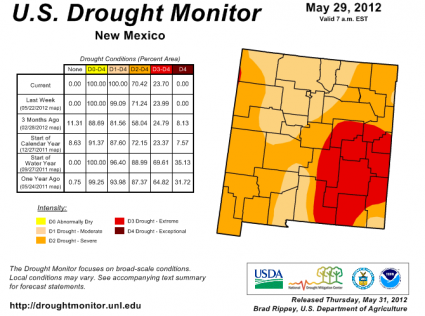by Andrew Freedman, via Climate Central
The largest wildfire in New Mexico’s history continues to burn, having already charred an area larger than New York City. Known as the Whitewater-Baldy Fire Complex, the wildfire has become another in a series of “megafires” to torch the American West due to an unprecedented combination of drought conditions, climate change, and alterations in land-management practices. To make matters worse, according to The Guardian newspaper, congressional budget cuts may restrict the federal government’s firefighting efforts during what is widely expected to be a busy wildfire season.
The Whitewater-Baldy Complex is burning in New Mexico’s rugged and mountainous Gila Wilderness, an area with steep terrain that has rendered much of the fire off limits to firefighters. Instead of attacking it from within, firefighters are trying to dig in around it, hoping to slow its spread.
The megafire is the result of a merger of two separate, relatively modest-sized fires. When the two merged in late May, the fire dramatically expanded, burning 70,000 acres in just one day. As of Friday, the fire had burned 216,000 acres, and was only 10 percent contained. More than 1,200 personnel were battling the fire. There have been no fatalities or major injuries.
The fire has surpassed New Mexico’s record fire, which occurred just last year. The Las Conchas fire burned more than 156,000 acres and came perilously close to Los Alamos National Laboratory, the birthplace of the atomic bomb.
New Mexico Gov. Susanna Martinez took a helicopter tour of the fire on May 31. “She described the terrain as “impossible,” saying there was no way for firefighters to directly attack the flames in the rugged areas of wilderness,” the Associated Press reported. She warned that it would continue to burn more acres as firefighters struggle to contain the blaze.

Much of New Mexico is experiencing drought conditions. Credit: U.S. Drought Monitor.
As Climate Central reported on May 23, the 2012 fire season is likely to continue the trend of severe wildfire seasons in the Southwest, due largely to the prevalence of long-term drought conditions in the region. Long-burning, massive wildfires have become more common in the U.S. recent years.
In fact, the recent Southwestern megafires stand out as unusual in the context of the past 1,500 years in that region, according to a recent study. The study found that land-management changes, such as years of fire suppression activities that stifled small fires, thereby priming forests for larger blazes, have combined with climate change to create forests that are altogether different — and which burn differently — from what existed in this area for generations.
“The U.S. would not be experiencing massive large-canopy-killing crown fires today if human activities had not begun to suppress the low-severity surface fires that were so common more than a century ago,” said Christopher I. Roos, an assistant professor in the SMU Department of Anthropology, according to Science Daily.
— Andrew Freedman is a senior science writer for Climate Central, focusing on coverage of extreme weather and climate change. Prior to working with Climate Central, Freedman was a reporter for Congressional Quarterly and Greenwire/E&E Daily.This piece was originally published at Climate Central and was reprinted with permission.JR: Here’s more from the Guardian story, “Wildfire budget cuts in Congress put communites in danger, experts warn”:
Fire experts are warning that $512m in congressional budget cuts could leave communities dangerously exposed in an early and active fire season.
Such warnings have sharpened with the early onset of this year’s fire season, and the record-setting outbreak in New Mexico.
Experts fear the shortfall will leave fire crews scrambling for resources, and force government agencies to dip into other non-fire budgets to cover the gap….
But the economic downturn and a Congress dominated by Republicans who want to shrink the role of government make it extremely complicated to divert more funds to forest fighting.
Instead, funding for preventing and putting out wildfires has fallen by $512m, or about 15%, since 2010.
Campaigners say that leaves the federal government agencies responsible for preventing and putting out wildfires under-funded — especially given projections suggesting a rise in wildfires over the next 20 years.
Related Climate Progress posts:
- Hell and High Water Stoke Texas Blaze: “No One on the Face of This Earth has Ever Fought Fires in These Extreme Conditions”
- Global Warming Boosts Worst Wildfires ‘Since the Last Ice Age’
- James Hansen Is Correct About Catastrophic Projections For U.S. Drought If We Don’t Act Now
- A figure from a 2010 presentation by the President’s science adviser Dr. John Holdren, about conditions projected for mid-century:
